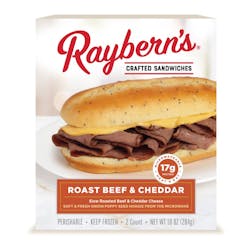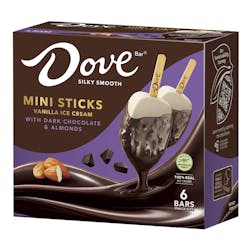Campbell Soup Co. reported its results for the third quarter of fiscal 2012.
Net earnings for the quarter ended April 29, 2012, were $177 million, or $0.55 per share, compared with $187 million, or $0.57 per share, in the prior year. The current quarter's reported net earnings included charges associated with a restructuring program announced in June 2011.
Excluding items impacting comparability, adjusted net earnings decreased 4 percent to $180 million, and adjusted net earnings per share decreased 2 percent to $0.56 in the current quarter. A detailed reconciliation of adjusted financial information to the reported information is included at the end of this news release.
Denise Morrison, Campbell's president and chief executive officer, said in a prepared statement, "We continued to advance our strategies to stabilize and then profitably grow North America soup and simple meals, expand our international presence and continue to drive growth in healthy beverages and baked snacks.
"Although overall sales trends are improving, we are not satisfied with our performance this quarter. As planned, we focused our marketing efforts on increasing advertising and consumer promotion. We executed well in some businesses, delivering solid sales growth in U.S. Beverages, Pepperidge Farm and Canada. We did not execute as well in others."
Morrison concluded, "We remain committed to our three growth strategies. At Campbell, we are building a business for the long term through innovation, brand building and expansion into higher growth segments that connect with today's consumers. We have made solid progress reinvigorating our innovation pipeline, and customers have responded favorably to the new products we have planned for next year. With continued focus on our strategies, we plan to deliver sustainable profitable net sales growth that will create value for shareholders."
As previously announced, Campbell expects net sales growth to be between 0 and 2 percent, a decline in adjusted EBIT of between 9 percent and 7 percent and a decline in adjusted EPS of between 7 percent and 5 percent, putting adjusted EPS in the range of $2.35 to $2.42, from the 2011 adjusted base of $2.54. Management expects to achieve this guidance range, with sales and adjusted EBIT near the lower end of the range and adjusted EPS, benefiting from a favorable tax rate, near the upper end of the range.
For the third quarter, sales were $1.821 billion, comparable to a year ago. The sales were impacted by the following factors:
Volume and mix subtracted 1 percent;
Price and sales allowances added 3 percent;
Increased promotional spending subtracted 2 percent.
Third-quarter financial details include:
Gross margin was 38.8 percent compared with 40.4 percent a year ago. The decrease in gross margin percentage was primarily due to cost inflation, increased promotional spending and unfavorable mix, partly offset by higher selling prices and productivity improvements.
Marketing and selling expenses increased 5 percent to $256 million compared with $243 million in the prior year, primarily due to higher advertising and consumer promotion expenses, partly offset by lower selling expenses. Advertising and consumer promotion expenses increased 13 percent, reflecting brand-building investments across most businesses.
Administrative expenses decreased $4 million to $144 million, primarily due to the benefit of cost savings from restructuring initiatives.
Earnings before interest and taxes (EBIT) were $264 million compared with $307 million in the prior-year quarter. Excluding items impacting comparability, adjusted EBIT in the current quarter was $268 million. Adjusted EBIT decreased 13 percent primarily due to the decline in gross margin percentage and higher advertising and consumer promotion expenses.
The tax rate in the quarter was 26.2 percent compared with 34.3 percent in the prior year due to lower taxes on foreign earnings in the current year.
Adjusted net earnings per share were $0.56 in the current quarter compared with net earnings per share of $0.57 in the prior-year quarter, a decrease of 2 percent. The decline reflected the lower EBIT, mostly offset by the impact of a lower tax rate and fewer shares outstanding.
Net earnings for the first nine months were $647 million, or $2.01 per share, compared with $705 million, or $2.11 per share, in the year-ago period. Excluding items impacting comparability in the current-year period, adjusted net earnings declined 7 percent to $653 million and adjusted net earnings per share declined 4 percent to $2.03.
For the first nine months of fiscal 2012, sales were $6.094 billion, comparable to the year-ago period. The sales were impacted by the following factors:
Volume and mix subtracted 3 percent;
Price and sales allowances added 4 percent;
Increased promotional spending subtracted 1 percent;
Nine-month financial details include:
Gross margin was 38.9 percent compared with 40.3 percent a year ago. The decrease in gross margin percentage was primarily due to cost inflation and increased promotional spending, partly offset by higher selling prices and productivity improvements.
Marketing and selling expenses increased $3 million to $814 million, primarily due to higher advertising and consumer promotion expenses, partly offset by lower selling expense. Advertising and consumer promotion expenses increased 2 percent, reflecting brand-building investments across several businesses.
EBIT was $1.009 billion compared with $1.110 billion in the prior year. Excluding items in the current year impacting comparability, adjusted EBIT declined 8 percent to $1.018 billion. The decrease was primarily due to the decline in gross margin percentage.
Cash flow from operations was $838 million compared with $858 million in the year-ago period. The decline reflected the impact of lower earnings, partly offset by lower cash payments associated with pension and other benefit plans.
Campbell repurchased 8.3 million shares for $272 million under its $1 billion strategic share repurchase program announced in June 2011 and the ongoing practice of buying back shares sufficient to offset those issued under incentive compensation plans.
Sales for U.S. Simple Meals were $567 million for the third quarter, a decrease of 2 percent compared to the year-ago period. A breakdown of the change in sales follows:
Volume and mix subtracted 5 percent;
Price and sales allowances added 4 percent;
Increased promotional spending subtracted 1 percent;
U.S. Soup sales declined 3 percent compared to the year-ago quarter.
Sales of "Campbell's" condensed soups decreased 5 percent, with declines in both cooking and eating varieties.
Sales of ready-to-serve soups decreased 1 percent, reflecting declines in microwavable soups, partly offset by the sales from the launch of "Campbell's Slow Kettle" soups. Canned ready-to-serve soup sales were comparable to a year ago.
Broth sales decreased 4 percent, primarily due to declines in canned broth, partly offset by the introduction of "Swanson Flavor Boost" concentrated broth.
U.S. Sauces sales were comparable to the year-ago quarter. Sales of "Prego" pasta sauce rose 3 percent driven by strong volume gains benefiting from increased advertising support and new items. Sales of "Pace" Mexican sauces were comparable to the prior year's quarter.
U.S. Simple Meals operating earnings were $120 million compared with $139 million in the prior-year period, a decrease of 14 percent. The decline in operating earnings reflected lower volumes, cost inflation, and increased advertising and consumer promotion expenses, partly offset by higher selling prices and productivity improvements.
For the first nine months, sales for U.S. Simple Meals decreased 2 percent to $2.265 billion. A breakdown of the change in sales follows:
Volume and mix subtracted 6 percent;
Price and sales allowances added 4 percent;
U.S. Soup sales declined 3 percent due to a 9-percent decrease in ready-to-serve soups and a 1-percent decrease in condensed soups. Sales of broth increased 3 percent.
U.S. Simple Meals operating earnings were $554 million in the first nine months compared with $556 million in the year-ago period. The slight decrease in operating earnings reflected lower earnings in U.S. Sauces, mostly offset by earnings gains in U.S. Soup. For the segment, lower volumes and cost inflation were mostly offset by higher selling prices, productivity improvements and lower promotional spending.
Sales for global baking and snacking were $543 million for the third quarter, an increase of 3 percent from a year ago. A breakdown of the change in sales follows:
Price and sales allowances added 6 percent;
Increased promotional spending subtracted 4 percent;
Currency added 1 percent.
Further details of sales results included the following:
Sales of "Pepperidge Farm" products increased, reflecting higher selling prices across the portfolio, partly offset by increased promotional spending.
In cookies and crackers, sales increased, driven by double-digit growth in "Goldfish" snack crackers, partly offset by declines in cookies.
Bakery sales decreased reflecting declines in the category.
Excluding the favorable impact of currency, sales in Arnott's were comparable to the prior year as strong growth in Indonesia was offset by declines in Australia.
Operating earnings for the quarter were $73 million compared with $82 million in the prior year. The 11-percent decline was primarily due to cost inflation and increased promotional spending, partly offset by higher selling prices and productivity improvements.
For the first nine months, sales increased 3 percent to $1.637 billion. A breakdown of the change in sales follows:
Volume and mix subtracted 3 percent;
Price and sales allowances added 6 percent;
Increased promotional spending subtracted 2 percent;
Currency added 2 percent.
Operating earnings decreased 12 percent to $232 million compared with $263 million in the year-ago period, primarily due to cost inflation, increased promotional spending and higher advertising, partly offset by higher selling prices and productivity improvements.
Sales for International Simple Meals and Beverages were $349 million for the third quarter, a decrease of 1 percent. The change in sales reflected the following factors:
Price and sales allowances added 4 percent;
Increased promotional spending subtracted 2 percent;
Currency subtracted 3 percent.
Excluding the impact of currency, higher sales in Canada, Europe and Latin America were partly offset by lower sales in the Asia Pacific region.
In Canada, sales increased primarily due to increased soup sales, partly offset by the negative impact of currency and lower beverage sales.
In Europe, excluding the negative impact of currency, sales increased due to volume-driven gains in France, partially offset by lower sales in Germany.
In the Asia Pacific region, sales decreased primarily due to declines in Australian soup, partially offset by the favorable impact of currency and growth in Japan and Malaysia.
Operating earnings were $37 million compared with $41 million in the year-ago period. The decrease in operating earnings was primarily due to lower earnings in the Asia Pacific region.
For the first nine months, sales decreased 3 percent to $1.110 billion. A breakdown of the change in sales follows:
Volume and mix subtracted 4 percent;
Price and sales allowances added 2 percent;
Increased promotional spending subtracted 1 percent.
The sales decline reflected lower sales in Europe and Canada, partly offset by gains in the Asia Pacific region.
Operating earnings fell to $138 million compared with $161 million in the year-ago period. The decrease in operating earnings was primarily due to lower earnings in the Asia Pacific region and increased costs associated with the company's market expansion in China.
Sales for U.S. Beverages were $208 million for the third quarter, an increase of 5 percent compared with the year-ago period. A breakdown of the change in sales follows:
Volume and mix added 7 percent;
Increased promotional spending subtracted 2 percent;
Sales gains, which continued to outpace category growth, were driven by double-digit growth in "V8 Splash" beverages and gains in "V8 V-Fusion" beverages. Sales of "V8 V-Fusion" beverages benefited from a range of new products, including Smoothies, Sparkling and Energy drinks, as well as higher promotional support.
Operating earnings for the quarter were $45 million compared with $54 million in the year-ago period. The decrease in earnings was primarily due to the impact of cost inflation, increased promotional spending and higher advertising, partly offset by volume gains.
For the first nine months, sales increased 2 percent to $593 million. A breakdown of the change in sales follows:
Volume and mix added 4 percent;
Increased promotional spending subtracted 2 percent;
Sales of both "V8 Splash" beverages and "V8 V-Fusion" beverages increased, while sales of "V8" vegetable juice declined.
Operating earnings declined to $109 million from $152 million, primarily due to cost inflation, increased promotional spending and higher advertising expense, partly offset by productivity improvements.
Sales for North America foodservice were $154 million for the third quarter, comparable to the prior year. A breakdown of the change in sales follows:
Volume and mix subtracted 2 percent;
Price and sales allowances added 3 percent;
Increased promotional spending subtracted 1 percent.
Volume-driven sales gains in fresh chilled soup sold at retail were offset by declines in frozen and canned soup.
Operating earnings decreased $2 million to $20 million due to the decline in gross margin percentage.
For the first nine months, sales increased 5 percent to $489 million. A breakdown of the change in sales follows:
Volume and mix added 2 percent;
Price and sales allowances added 3 percent.
Operating earnings were $75 million compared with $66 million in the year-ago period, an increase of 14 percent. The increase in operating earnings was primarily driven by higher selling prices, productivity improvements and volume gains, partially offset by cost inflation.




